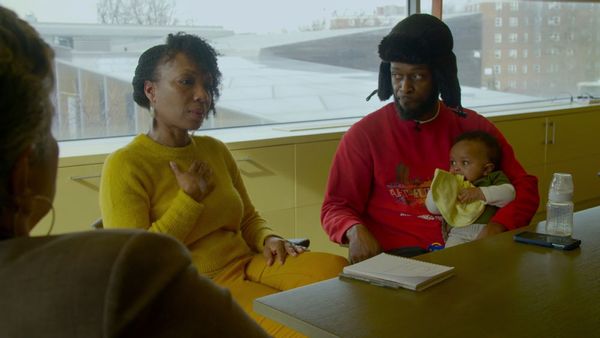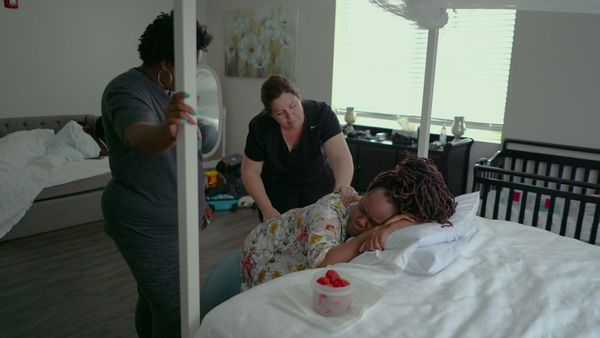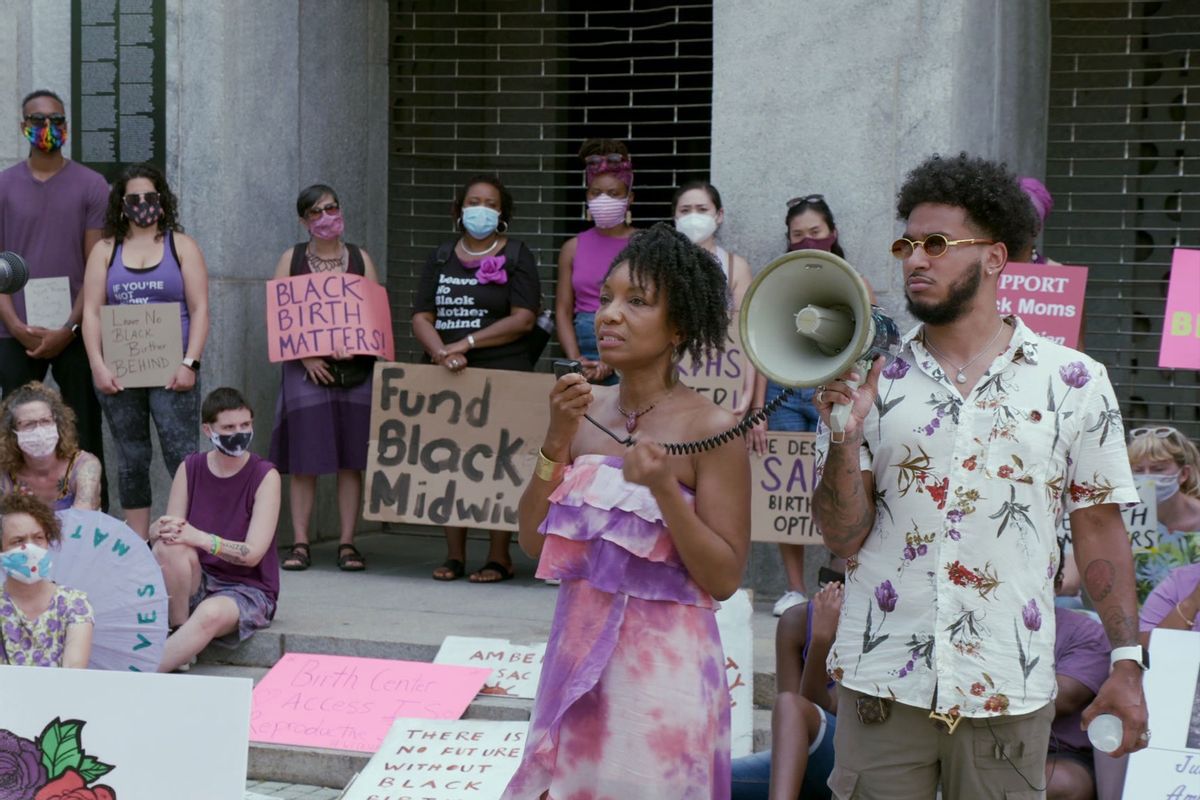Hulu's new documentary "Aftershock" is devoted to examining the obscene disparity in maternal mortality rates that Black women face, but its climax centers on a smooth, problem-free delivery at a birthing center. Part of what makes it so extraordinary is the gentle attentiveness that directors Paula Eiselt and Tonya Lewis Lee capture in the hours leading up to the birth: the mother-to-be eats strawberries, receives a massage from a midwife to relieve her pain, and breathes deeply. When the moment arrives there is no screaming, just an exhaled sigh and joyful relief.
To Eiselt and Lee, showing how calm birth can be when Black women are respected and empowered to control their experience is an essential part of revealing why America's medical system fails so many of them.
According to the Centers for Disease Control and Prevention, in 2020 (the most recent year for which this data exists) the maternal mortality rate per 100,000 births was 55.3 for Black women, 19.1 for white women, and 18.2 for Hispanic women. Eiselt and Lee recognize how distressing those statistics are. In fact, those numbers are part of the reason she chose to take on this subject.
"Maternal health is something that is very close to me, as a mother and an artist," Eiselt explained to Salon in a recent interview. The mother of four recalled her own traumatic, adverse pregnancy and birth experiences while also recognizing the difference between the level of care she received versus that of women like 30-year-old Shamony Gibson, who died in 2019 after the birth of her son, and 26-year-old Amber Rose Isaac, who died in 2020 after an emergency Cesarean section, which her family insists was a result of medical negligence.
The United States is the most dangerous country in the industrialized world to give birth, Eiselt said. In partnering with Lee, who served as the spokesperson for the Office of Minority Health's infant mortality awareness-raising campaign in 2007, Eiselt's goal was to create moving portraits from these stories.
Through "Aftershock," we follow Shamony's mother, Shawnee Benton Gibson, her grieving partner, Omari Maynard, and Amber's surviving partner Bruce McIntyre as they transform the pain of their loss into activism. The documentary shows how much work still lies ahead to bring down the Black maternal mortality rate and prevent other families from sustaining such a terrible loss while also contextualizing the failures in the medical profession with a look at history, but as Eiselt and Lee explain, there is reason to hope as long as women can exercise their right to choose how and when they give birth.
This interview has been edited for length and clarity.
Before making the documentary, just in terms of just approaching subjects, what where the things that you knew specifically that you wanted to do, or issues that you had to cover?
Paula Eiselt: First and foremost, the people are what make stories. There are amazing articles, but articles are not films. And it was really important to find those protagonists who . . . viewers will relate to. So when Tonya and I sat down, we decided first and foremost, this needs to be a human story. This isn't going to be a statistically driven story, although we pack in a lot of that. But all of that comes underneath the stories of the people. So we were very clear that we wanted minimal experts. Dr. Neel Shah, and Helena Grant, they became the tentpole experts. But they're also characters in the film.
And of course, from day one, the foundation of this film was always going to be in the work of Black women. That was very clear. There's no way to tell the story of the U.S. maternal mortality crisis, which does affect all women, without having the foundation center Black women. There's really no other way to do it. So we were both very clear on that.
Tonya Lewis Lee: I think that Paula and I also had very early conversations about who was going to be behind the camera, who was going to be around when we went into film. For example, for the men's circle, we knew we wanted a Black male DP in that room. We were very sensitive to that even as we were thinking about, you know, who is on our crew? What do they look like? What's their level of sensitivity? Who is going to be working with these families?
"The fathers are the ones left behind to have to pick up the pieces."
And Paula and I had a lot of real conversations. This is an issue about race, Paula is not a Black woman. And it was really important that we be able to be open in those conversations. They're not always easy. But the best work is when you're able to have open and honest conversations about race, because it is sensitive.
How do we – when we're talking to Shawnee, and Bruce, and Omari – show understanding? And by the way, I'll tell you, Shawnee herself is very direct. She will tell you how she feels, how she thinks, and she was also very critical in terms of just talking about issues of race very openly with all of us. And so I think that also made for us to be able to make the film in . . . the tenor and the tone that we did.
 Shawnee Benton Gibson and Omari Maynard in "Aftershock" (Hulu/Onyx Collective)
Shawnee Benton Gibson and Omari Maynard in "Aftershock" (Hulu/Onyx Collective)
A few things about "Aftershock" struck me as unique. One of them is that when we think about maternal health, regardless of race, we think about it in a way that's usually centered on just those giving birth. What this film does that's really important is showing the partners, the men and the partners, who are left behind when the birth parent dies. Tonya, you addressed this a little bit when you were talking about going into those rooms and speaking to men who have lost their wives and partners. Was that a direction that you predicted the documentary would take?
Lee: As we talked about that first event that we filmed, Aftershock, the call to action that Shawnee put out, it was really a celebration of the life of Shamony. At that event, they also held the men circle that Omari ran. That was the pivotal moment for us to understand as filmmakers, the impact that the death of these women have on men. So we followed Omari.
And by the way, they're the ones that are left behind. I think people often think about maternal health as a woman's issue, but it's really a family issue. It's a community issue. And so we embarked on following Omari as he's trying to pick up the pieces of his life, continuing to work, raise his children without Shamony there, and then Omari, just being who he is, and reaching out to other fathers who have experienced that loss, helped to direct us to Bruce. It was really, truly organic. But you know, when you look back, of course it makes sense. The fathers are the ones left behind to have to pick up the pieces.
There's so much conversation in the film about the medical industry practices surrounding gynecology and obstetrics – and how it has been removed from traditional midwifery, and how Black women have been decoupled from that process. I'm thinking about the wonderful but also very noticeable distinction between birthing center versus going into the hospital in Tulsa and seeing this sign declaring, "We're Team Birth" . . . and it's all white women. Was this an aspect of maternal health cases that you look at differently now after this production versus when each of you were going through your own birthing experiences?
Eiselt: To just briefly touch on the history that we show, of what happened to enslaved Black women in terms of experimentation, and then what happened in the 19th century, with the stigmatization of midwives, and, really, white men taking over that profession, that has set in motion this entire crisis. This is just part of that same story of women, especially Black women losing their autonomy in every way and being robbed of this profession.
This isn't something novel. This isn't some anti-medical, anti-technology view. The countries with the best [maternal health] rates have midwives, because they provide the best outcomes. That's science. That's evidence.
So, I think going in knowing that history, we always wanted it to be there. And knowing the system of the U.S., the maternal health system, and what it lacks, was something really important to show.
My experiences in the hospital, I've experienced every type of birth. I've had a C-section, I've had a drug-free birth, I've had an epidural birth. I've seen the way that the system operates. And then choosing to have a midwife with my fourth child, it wasn't perfect, but it's a vastly different experience. So taking all that knowledge of how I know this system works from the inside, knowing what wasn't there was something we did want to show.
"The countries with the best [maternal health] rates have midwives, because they provide the best outcomes. That's science. That's evidence. "
Felicia, the woman who does have that amazing birth center birth, that's something that was not planned. When we started following Felicia, she was going to have a birth in one of those hospitals that you see in Tulsa. She even had a great rapport with her providers. But ultimately, she chose a birthing center. And actually, her doctor that she was going to use was a Black man, a lovely doctor.
But she chose the woman's space. She felt that for her, and for the birth that she wanted, and the empowerment that she wanted, that was the place to go. We were able to pivot the story right away.
Lee: For me, when I had my children 27, 25 years ago, I had hospital births. I hadn't even thought about a midwife, really. The campaign that was waged against midwives did a great job, and it did a great job on me.
But I will say, as we began doing the research and learning and discovering, I remember an early article that I read about how George Washington paid his enslaved midwife because she was so valuable to the plantation. That was such an a-ha moment for me personally, because it was like, Oh. So the midwife on the plantation, who is bringing forth the labor force, is so valuable to George Washington that he pays her, even though she remains enslaved. Because not only is she administering to the labor force, she's administering to his family, his overseers and people outside of the community.
So that sort of began my awareness of the power of midwives; I was woefully ignorant. And I'm just grateful for Helena Grant, who is the midwife that we feature in the film, who really opened my eyes to a lot of the history of what you see in the film.
 Aftershock (Hulu/Onyx Collective)
Aftershock (Hulu/Onyx Collective)
Since Roe v. Wade was overturned, there have been stories coming out of Oklahoma about the immediate impact on that community. Choosing to film in Oklahoma for this documentary seems very prescient. What was behind that choice? And more specifically, what went into your choice to venture into Tulsa?
Lee: Well, the making of this entire film is divinely ordered. So let's start with that. I remember talking to some folks in Tulsa early on, when we weren't even thinking about going there. And they told us about this doctor who was in Boston, who they were doing some work with, and we sort of heard that, but we didn't make the connection: It was Neel Shah.
Eiselt: We met him before.
Lee: Yeah, we had met Neel before that. But we didn't make the connection. . . . Then we got back to Neel Shah, who was working, as you say, with Team Birth there in Tulsa, and so we decided that we were going to follow Neel. We heard about what he was doing with Team Birth, and we wanted to see if Team Birth is something that really could work. So we went down to Tulsa.
And I say that it's divine because it makes so much sense that we would be in Tulsa. We all know they just had the centennial of the race massacre down there. It is no wonder that the birth outcomes in a place like Tulsa are so bad, because the racial equity down there in general is bad and people don't want to deal with the issues.
And there are some good things happening there at the same time.
Want a daily wrap-up of all the news and commentary Salon has to offer? Subscribe to our morning newsletter, Crash Course.
I'm wondering if there was an outcome that you thought might happen when you were going there that surprised you the most.
Eiselt: When I went into that community, we wanted a birth. That's really why we went to Tulsa. I mean, part of it is we wanted to see if Team Birth itself was something that could really be effective. So we followed several [women] who were going to give birth, and we wanted to capture that birth. There was a hospital births that we filmed that did not make the film. There was another woman who was contemplating a hospital birth, but then was going to have another kind of birth, but she ended up back in the hospital.
And then there was Felicia, and by luck of the draw, and chance of chances, we were able to capture Felicia have a beautiful, beautiful birth.
That birth was amazing to witness in a documentary that is talking about maternal mortality. There is a lot of sorrow, there's a lot of shock, but then you have this vision of this is how birthing can be.
Eiselt: I mean, Felicia is the promise of what it could be when women choose – because choice is everything – choose where they birth, with whom they birth, who's in the room, this is the result of what an integrated system could look like. So it was so important to show that hope.
We did not want to tell a doom and gloom story. And you know, of course, with Shawnee and Omari and Bruce, they are not doom and gloom, people. They turn their pain into power. So it was never going to be that. But with Felicia's birth, it takes it to another level of really showing what empowered birth looks like and showing what real birth looks like.
We don't see representation of the process of birth, of labor. We see some women screaming their heads off in a hospital and completely out of control. We don't see, you know, the sereneness of her birth.
And again, not everyone needs to have a birth like this, but we need representation so people could make that choice.
Lee: One thing I'll add to that is, the last thing that I want is for Black women to be afraid to give birth. And so it was essential that we be able to show what a positive birth looks like, and what a dignified, safe, beautiful birthing process can be.
We don't want people to be afraid. We want people going into birthing excited about the journey.
I love in the film is when Felicia says, "This is the hardest thing I've ever done in my life." Because it is hard. And I have a spiritual belief that, well, as a midwife, as Helena Grant, said to us, when a woman is birthing, she's not only birthing a child, she's birthing a mother. And to go through that process of birthing, as hard as it is, I believe it makes us the best mothers that we can possibly be.
"Aftershock" is currently streaming on Hulu. Watch a trailer, via YouTube.
https://www.youtube.com/watch?v=k63RC0rJEd8
Read more
about maternal health and motherhood in America

Shares